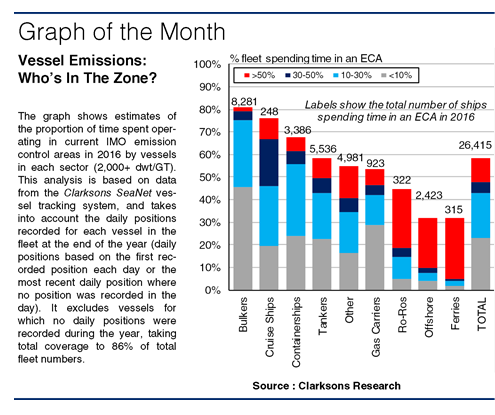Air pollution is rising up the regulatory agenda and one way in which the maritime sector has responded is through the creation of emission control areas (ECAs), primarily aimed at limiting vessels’ SOx and NOx emissions.

Mapping Out The Rules
Vessels sailing in emission control areas (ECAs) are subject to stringent emissions limits. There are currently four IMO SOx ECAs, where ships must adhere to a 0.1% limit on the sulphur content of fuel: the North Sea, the Baltic Sea, North America and the US Caribbean Sea. This is stricter than the IMO’s 0.5% global sulphur cap which will be effective from the start of 2020. Further, vessels with a keel laid from 1st January 2016 onwards must comply with NOx Tier III emission limits when sailing in the North America and US Caribbean Sea ECAs. The North Sea and Baltic Sea will also become NOx ECAs from the start of 2021. In order to comply with ECA limits, ships must either use low sulphur fuels, alternative fuels such as LNG (which meets both SOx and NOx ECA limits), or invest in emissions abatement technology such as SOx scrubbers and/or NOx selective catalytic reduction systems. In addition to IMO ECAs, there are a number of national ECAs with both the EU and China imposing SOx limits (typically 0.5%).
Emission Possible?
While many ships may have altered their routeings in order to minimise the amount of time spent in ECAs, on the basis of the analysis here, an estimated 58% of the c.45,000 ships for which daily positon data was recorded spent time in an ECA in 2016. A large proportion of these ships typically spent fewer than 75 days operating in an ECA. However, the proportion of time spent in an ECA varies by ship type. Looking at the major vessel sectors, 81% of bulkers, 68% of containerships and 58% of tankers spent time an ECA last year. This is more than 17,000 vessels but most of these ships spent less than 20% of their time in ECAs.
Vessels In The Zone
Meanwhile, an estimated 4,875 ships spent over 50% of last year operating in an ECA. 27% of ferries and Ro-Ros spent over half of their time in ECAs during this period, illustrating their concentration in the North and Baltic Seas. 22% of offshore units also spent more than half of 2016 in ECAs with many vessels operating in the North Sea and US Gulf. Generally, ships spending significant time in ECAs are the most likely retrofit candidates for emissions abatement technologies. However, market conditions may not support the economics of the retrofit of older ships and they could be recycled instead, potentially generating demand for new vessels to meet the regulations.
So, ECAs impact a large number of ships across the merchant fleet. While fewer vessels spend a large proportion of their time in ECAs in the major sectors, there are a number of segments where ECAs have a big impact on vessel operations. Whether owners invest in reducing ships’ emissions will depend on a number of factors but the amount of time they spend in ECAs is certainly a key consideration.
https://sin.clarksons.net/features/Details/49651








